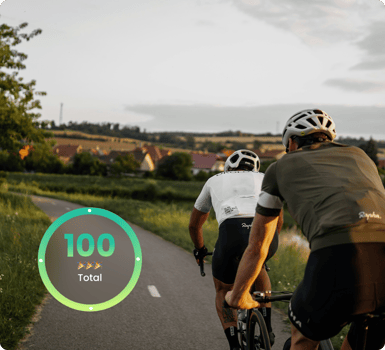The research behind
The research
Mia Health is based on world-leading research from The Norwegian University of Science and Technology (NTNU). The AQ algorithm shows how much physical activity you need to reduce your Fitness Age and improve your health.


Based on HUNT
The health survey in Trøndelag (HUNT) is one of the world's most extensive health surveys. HUNT is an important source to knowledge about public health and developing more efficient health services in Norway. Mia Health has been developed with data from HUNT.


Developed by CERG, NTNU
The Cardiac Exercise Research Group (CERG) at NTNU studies the effects of exercise as medicine. Mia Health's AQ and fitness age have been developed by CERG to give people effective tools to maintain the best possible health throughout their lives.

One million participants

What is AQ?
AQ is a simple, smart scoring system that rewards you for every activity that gets your heart rate up. Your personal AQ shows how much each workout actually improves your health.
Developed by NTNU and Mia Health, the AQ algorithm is backed by decades of research and data from over one million people.
This gives you the most accurate measure of the health benefits from physical activity ever created.
The four main AQ principles
Low heart rate does not increase your AQ
Only exercise that contributes to improved fitness earns points. Therefore, the lower limit for earning AQ will be around 60% of maximum heart rate for most people.
The more out of breath, the higher AQ
The AQ earning rate increases as you exercise with a higher heart rate. For most people optimal AQ earnings per minute are achieved at at heart rate around 90 % of maximum.
Maximal effort is not necessary
Physiological adaptations level off before you reach maximum heart rate. Therefore, exercising to total exhaustion will not result in extra health benefits - or AQ.
Six days of rest in a row is not ideal
Achieving optimal health benefits from physical activity requires at least two active days each week. Therefore, you can earn a maximum of 65 AQ each day.

Significant findings from the research
Lower risk of premature death
An AQ of 100 is linked to 75 % reduced risk of premature death compared to being physical inactive. 80 % of these benefits are reached already at an activity level corresponding to 50 AQ. A person staying at 100 AQ or above for most of his lifetime could expect to gain 13 extra years of good health.
Every VO2 max increase of 3,5 mL/kg/min, estimated with the NTNU formula, is linked to 15 % lower risk of premature death in men and 8 % reduced risk in women.
Lower risk of cardiovascular diseases
100 AQ is linked to up to 50 % reduced risk of most cardiovascular diseases, including heart attacks and angina pectoris, in men and women of all ages.
Every increase of 3,5 mL/kg/min in estimated VO2 max is linked to 21 % lower risk of dying from cardiovascular diseases in both men and women.
Lower risk for dementia
People who maintain an activity level of 50 AQ and more over time have a significantly lower risk of developing dementia over the next 25 years, and the risk of dying from or with dementia is reduced by up to 50 %. Increasing AQ over time (from below to above 50) is also associated with nearly the same benefits.
Every increase of 3,5 mL/kg/min in VO2 max estimated with NTNU's formula is linked to 16 % lower risk of dementia.